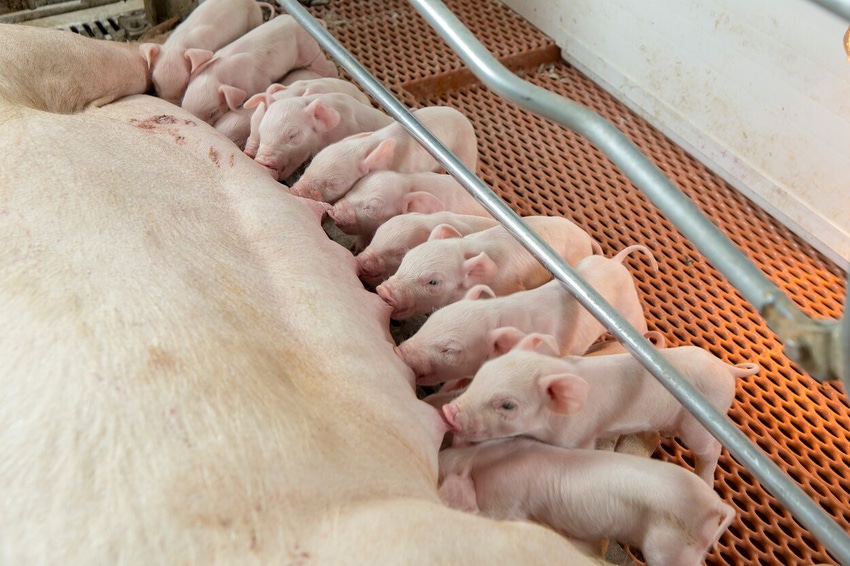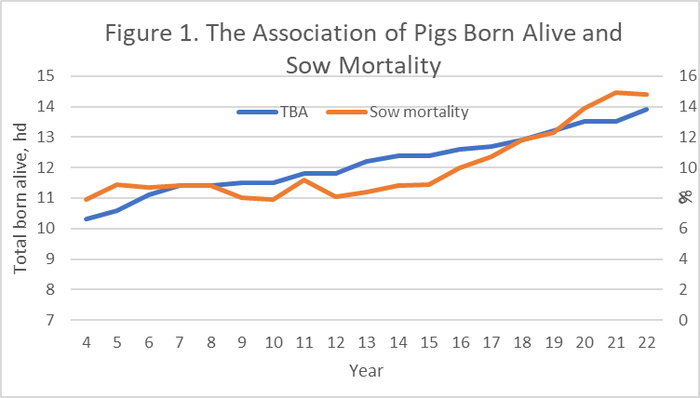Research focusing on the sow
To achieve a different outcome for sow mortality rates, all farm management practices need to change to be aligned with the demands of farrowing larger litters.
July 20, 2023

Baseball is a great game, especially in the late summer and fall when the playoffs start. The game has strategies for different points in the game and statistics help guide decisions on which players to use and when. One of my favorite baseball movies was Money Ball. The story is about the manager of the Oakland A's, Billy Beane, and the challenge of being competitive with a limited payroll – the industry can relate! He is credited with the use of statistics for player evaluations to assess value and achieving success in the game.
One of his quotes when the A's scouts were raving about a player's hitting was "if he is such a good hitter, why doesn't he hit good?" I think that relates to our prolific sows. Prolificacy of commercial sows is high and going higher but durability — defined as the ability to complete a function multiple times — is regressing. Durability is not a target of our systems. Research data from a large commercial system indicates over 50% of its first parity sows did not successfully wean a second litter and that is representative of most systems. The additional burden of sow mortality on the sow farm production team is tremendous and the substantial investment in the sow is lost with a sudden sow death or removal. We underestimate the soft costs and the toll of sow death loss on care-takers and farm managers. The value of the sow at farrowing is certainly greater than the number of pigs born and its cull value.
Much of the discussion on sow mortality has used records and associations in hopes of understanding the issues. I think associations and survey data can be misleading, but I believe there is one association we need to consider for the future - the strong association between prolificacy and sow mortality. Based on the last decade of PigChamp data, the correlation of sow mortality with pigs born alive has an R2 of 0.82. In considering the trends, sow mortality could exceed more than 20% when total pigs born reaches 18-20 pigs, if changes are not implemented. Changing the trend will require greater knowledge of the causes of sow mortality rather than associations. When well-trained and experienced sow farm managers struggle with the incidence of prolapses and identify most mortality cases as "unknown," we need to know more about the sow. Reducing mortality is a pitch that we need to be able to hit.

I agree with past thoughts from Ron Ketchem that the information on causes of mortality needs improvement with relevant categories. But we also need prospective studies, an understanding of the physiological impact of prolificacy, and, most importantly, fresh ideas. One more quote from Billy Beane:
"I don't want a lot of guys like me who played the game. Quite frankly, I want blank canvases; I want people to come in with new ideas. I don't want the biases of their own experiences to be a part of their decision-making process."
Our group has an un-biased student in Lauren Olson who is diving into sow health at farrowing. She has an equine background, spends long hours in our research barn, and sees the challenges. We are focused on peri-parturient health because farrowing is the time when mortality is highest in sows — more than 25% of mortality is at farrowing — and when the physiological impact of prolificacy is most evident. We are working on a sow-specific tool – a mortality risk profile. Here are some initial observations from our barn time and data collection.
Assuming you have followed the "checklists" for gilt development and sow body condition and a procedure for farrowing assistance, two different sets of tools are useful to reduce the risk of mortality. A set for sows prior to and during farrowing and a set for post-farrowing care.
We found we need to develop a farrowing ease score. The score inputs we are evaluating in research are farrowing duration, farrowing assistance, restlessness, heart and respiration rate, and savaging activity. A stopwatch and a farrowing observation card are needed to record information for caretakers. Farrowing ease is going to be especially important with increases in pig birth weight and the number of pigs born. Our average farrowing duration for gilts was about six hours in a recent study. Farrowing is physically demanding in prolific sows.
The most critical time in a gilt and sows' life — the 48 hrs post-farrowing. We can reduce sow mortality today in this period. At this point, there are no cost-effective treatments or methods to prevent or treat vaginal and uterine prolapses. Even with low heritability, genetic selection appears to be the best long-term route for remediation. But we can work together to look diligently for sows with retained pigs.
As numbers of pigs born rise and farrowing duration follows, so will the frequency of retained pigs. The thermometer for post-farrowing care is as important as the glove in baseball. Taking a body temperature on sows that don't get up to eat or drink is important. Labored breathing and elevated respiration rate should also be recorded, and action taken. Taking a temperature helps separate sows in need of treatment from those that just won't get up to drink on their own.
Caretaker time is needed for at least four observations per day of feed and water intake. Identify sows early and get sows up to drink if necessary to ensure they stay hydrated. Recent research is reporting post-natal infections and complications as important contributors to sow mortality and we should know that prolificacy increases the need for post-farrowing care.
Last, a good team must have an effective means of communication in farrowing care. I don't have enough experience with technologies in this area to offer advice, but I can't emphasize enough that your attitude towards the sow that has farrowed for 8-10 hours needs to be one of offering intensive care. A sow's state of health can change quickly, within hours, even minutes. I am amazed at the responsiveness of some sows to timely treatment. If communication on the current state of a sow is fluid and effective, we can reduce mortality.
Remember the quote on "hitting good." The trend for higher sow mortality is an outcome driven by our systems and management practices in genetic selection, health, and nutrition. To achieve a different outcome for sow mortality rates, all our farms management practices need to change to be aligned with the demands of farrowing larger litters.
You May Also Like



